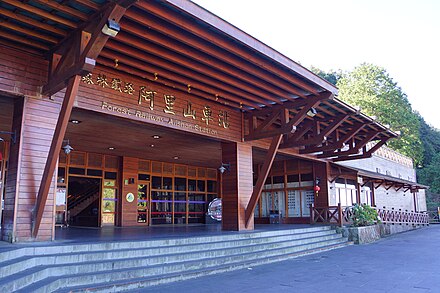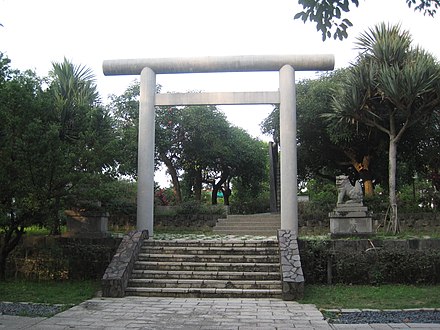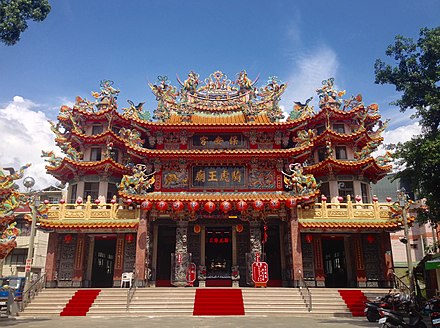Chiayi County - county in Taiwan
Chiayi County (嘉義縣) a southwestern region of Taiwan surrounding but not including Chiayi City.
Regions
{{Regionlist | region1name=Cities | region1color= | region1items=Taibao, Puzi | region1description=
| region2name=Urban townships | region2color= | region2items=Budai, Dalin | region2description=
| region3name=Rural townships | region3color= | region3items=Dapu, Dongshi, Lioujiao, Lucao, Meishan, Minxiong, Shuishang, Xikou, Xingang, Yizhu, Zhongpu, Zhuqi | region3description=
| region4name=Mountain indigenous township | region4color= | region4items=Alishan | region4description= }}
Chiayi County is divided into 2 cities, 2 urban townships, 13 rural townships and 1 mountain indigenous township. Taibao City is the seat of Chiayi County and is home to Chiayi County Government. The Chiayi County Council is however located in Puzi City.
Cities
- Taibao (太保市)
- Puzi (朴子)
Understand
Chiayi County borders Mount Yu to the east, Taiwan Strait to the west, Tainan City to the south and Yunlin County to the north. It spans over 1,903 km², about 5.35% of the area of Taiwan. Chiayi County is located along the Tropic of Cancer.
Get in
By train
 Chiayi County is connected to other parts of Taiwan by the HSR network by Chiayi HSR station (高鐵嘉義站). and the TRA network via the following stations:
Chiayi County is connected to other parts of Taiwan by the HSR network by Chiayi HSR station (高鐵嘉義站). and the TRA network via the following stations:
| Name | Chinese | Line | Location | Notes |
|---|---|---|---|---|
| Dalin. | 大林 | Western Trunk line | Dalin Township | |
| Minxiong. | 民雄 | Western Trunk line | Minxiong Township | |
| Nanjing. | 南靖 | Western Trunk line | Shuishang Township | |
| Shuishang. | 水上 | Western Trunk line | Shuishang Township |
By plane
The city is accessible by plane via Chiayi Airport (嘉義航空站). . The airport operates flights by UniAir to Penghu and Kinmen.
By boat
Budai Port (布袋港), 23.379089864948824°, 120.13944876506226°. provides ferry services to Magong City, Penghu.
Get around
By train
 The county is also home to the historic Alishan Forest Railway. The majority of the stations built along the railway were built between 1910 and 1912; some have since fallen into disuse and others have been renovated to cope with the demands of tourists.
The county is also home to the historic Alishan Forest Railway. The majority of the stations built along the railway were built between 1910 and 1912; some have since fallen into disuse and others have been renovated to cope with the demands of tourists.
| Name | Chinese | Line | Location | Notes |
|---|---|---|---|---|
| Alishan. | 阿里山 | Alishan Forest Railway | Alishan Township | The station building is made of wood with a row of arched wooden pillars. The station also has a spacious viewing platform. |
| Duolin. | 多林 | Alishan Forest Railway | Alishan Township | |
| Erwanping. | 二萬坪 | Alishan Forest Railway | Alishan Township | |
| Pingzhena. | 屏遮那 | Alishan Forest Railway | Alishan Township | |
| Shenmu. | 神木 | Alishan Forest Railway | Alishan Township | The station was named after a famous 3,000 year-old sacred tree locally known as Shenmu. However, the tree was toppled in a storm in 1997. |
| Shizilu. | 十字路 | Alishan Forest Railway | Alishan Township | |
| Zhaoping. | 沼平 | Alishan Forest Railway | Alishan Township | The station was in important hub for the logging industry and the largest log collection center during the Japanese rule. The station was re-inaugurated on 21 April 2013 after refurbishment made by Chiayi Forest District Office. |
| Liyuanliao. | 梨園寮 | Alishan Forest Railway | Meishan Township | |
| Dulishan. | 獨立山 | Alishan Forest Railway | Zhuqi Township | The station houses a water crane used to fill the steam locomotives of trains passing through. |
| Fenqihu. | 奮起湖 | Alishan Forest Railway | Zhuqi Township | |
| Jiaoliping. | 交力坪 | Alishan Forest Railway | Zhuqi Township | |
| Lumachan. | 鹿麻產 | Alishan Forest Railway | Zhuqi Township | The station building was built in 1910 during the Japanese rule from timber in a Japanese style. The current building was reconstructed after the line became popular with tourists. |
| Mululiao. | 木履寮 | Alishan Forest Railway | Zhuqi Township | |
| Zhangnaoliao. | 樟腦寮 | Alishan Forest Railway | Zhuqi Township | |
| Shueisheliao. | 水社寮 | Alishan Forest Railway | Zhuqi Township | |
| Zhuqi. | 竹崎 | Alishan Forest Railway | Zhuqi Township |
See
History and culture

- Fenqihu Old Street (奮起湖老街), 23.505130516288776°, 120.69495233947275°, +88652593900. 06:00-21:00. A small street with a number of old houses selling a range of take-away food and snacks. 2021-01-11
- High-Heel Wedding Church (高跟鞋教堂). The building is shaped like a high-heel shoe 17.76 meters in height, 11.91 meters in width, and 25.16 meters in length. It is composed of over 300 pieces of blue-tinted glass. The church is famous for its use as a wedding venue. However, the building is not consecrated and has no religious function. 2021-01-11
- Tomb of Wang De Lu (王得祿墓), 23.52182314735344°, 120.30744453910275°. The tomb of Wang De-lu, a soldier of the Qing dynasty. Because of his success as a soldier, he was ennobled by the imperial court, which also donated money for a lavish funeral and a huge tomb - the largest extant in Taiwan. 2021-01-11
- Tōseki Shrine (東石神社), 23.467608765787197°, 120.25430078091047°. 2021-01-11
- Tree Spirit Pagoda (阿里山樹靈塔), 23.517295047017292°, 120.80856145444734°. Although it is named the Tree Spirit Pagoda, it is actually a cenotaph. Japanese believe that trees have a divine spirit in the Kodama folklore. 2021-01-11
- Tropic of Cancer Monument (嘉義北回歸線標誌). The first monument was built in the 34th year of Guangxu Emperor's reign. The current building was completed in 1995. The monument is on the Tropic of Cancer line which cut across Taiwan. 2021-01-11
Museums and galleries

- Alishan Museum (阿里山博物館). 2021-01-11
- Dongshi Natural Ecological Exhibition Center (東石自然生態展示館). The center exhibits the history of the local rural villages, fishing tools, and wetland ecology. 2021-01-11
- Fenqihu Historical Exhibition Gallery (奮起湖文史陳列館). 2021-01-11
- Mei-Ling Fine Arts Museum (梅嶺美術館). An art museum in Puzi Art Park. 2021-01-11
- National Radio Museum (國家廣播文物館). A museum about radio broadcasting in Minxiong Township. 2021-01-11
- Xikou Township Cultural Life Center (溪口鄉文化生活館). A cultural center in Xikou Township. 2021-01-11
Temples


.jpg/440px-Zhaoqing_Buddhist_Temple,_Dalin,_Chiayi_(Taiwan).jpg)
- Bantianyan Ziyun Temple (半天岩紫雲寺). A moderately sized Buddhist temple that houses a large statue of the Bodhisattva Guanyin. 2021-01-11
- Chingchen Temple (慶誠宮). An ornate temple structure; the original building was constructed in 1809, but collapsed in an earthquake a century later. The current structure was rebuilt using donations from the local community in 2000. 2021-01-11
- Dashiye Temple (大士爺廟). A relatively small Buddhist temple that was built in 1923. It is listed as a Grade III historic building by the government. 2021-01-11
- Dongshi Fuling Temple (東石鄉福靈宮). A large, ornate Buddhist tample that traces its history back to 1684; the current temple complex was moved to this site in 1871. 2021-01-11
- Dongshi Xiantian Temple (東石先天宮). An impressive temple structure that was erected in 1721 and dedicated to the worship of Taibai Jinxing. 2021-01-11
- Fenqihu Catholic Church (奮起湖天主堂), 23.50273767578334°, 120.69701316451192°. 2021-01-11
- Fongtien Temple (新港奉天宮), 23.556537659053646°, 120.3478769423459°. A multi-storey Mazu temple with a very ornate roof. There is a festival dedicated to Mazu held every year on 23rd day of the third month of the lunar calendar. 2021-01-11
- Guogou Jiande Temple (過溝建德宮). A rather drab temple building from the outside, the original building was constructed during the late Qing dynasty, however the current structure was rebuilt in 1959. 2021-01-11
- Kaiyuan Temple (開元殿). A relatively young temple (built in the 1970s), this is notable for housing the world's largest statue of the notable Chinese admiral Koxinga (Zheng Chenggong). 2021-01-11
- Longyin Temple (龍隱寺), 23.438939441273654°, 120.60729205888885°. A grand, ornate temple that sits at the convergence of two rivers, each with a pedestrian suspension bridge crossing over them. 2021-01-11
- Peitian Temple (朴子配天宮). The Peitian Temple was established in 1682 and is largely responsible for the growth of the surrounding area. The Peitian Temple is a center of Mazu worship and pilgrimage on Taiwan. 2021-01-11
- Shouzhen Temple (阿里山受鎮宮), 23.517590147039215°, 120.81060956793884°. The temple was built shortly after the end of the Japanese colonial period for the workers who built the Alishan railway. The temple is famous for the many moths that visit the temple that, it is claimed, do not to try to eat the offerings or adornments of the statues. 2021-01-11
- Singang-Shui Xian Temple (笨港水仙宮), 23.56187981905117°, 120.3087790967759°. 2021-01-11
- Sugar Factory Mazu Temple (糖廠配天宮). 2021-01-11
- Tiger Riding Temple (騎虎王廟). The temple is named for the 5 statues of the deity riding a tiger. The history of the temple dates back to 1762, although it has been reconstructed several times since then. 2021-01-11
- Wanbei Fengshan Temple (灣北村鳳山宮), 23.50344282344917°, 120.30677172561082°. Shuixian Temple was built in 1739 for residents to pray for the safety of the boatsmen, but later destroyed in a flood in 1803 and rebuilt in 1814. Shuixian Temple is dedicated to Shuixian Zunwang. The five figures (Yu the Great, Xiang Yu, Wu Zixu, Qu Yuan, and Lu Ban) are housed in the main hall, with Yu the Great in the middle. The front hall is dedicated to Mazu, while the rear hall is dedicated to Guan Yu. Shuixian Temple is also home to several historical artifacts. In the rear hall, there is a plaque and a pair of dragon pillars that date to the reign of Jiaqing Emperor (1796-1820). The menshen and other paintings were done by famed painter Chen Yufeng (陳玉峰, 1900-1964). 2021-01-11
- Wufeng Temple (吳鳳廟). A small, but locally significant, temple dedicated to the local merchant Wu Feng that was erected in 1820. The legend says that he made effort to establish more friendly relations with the local indigenous tribes in the area. 2021-01-11
- Zhaoqing Buddhist Temple (昭慶禪寺), No. 41, Zhongzheng Road, Dalin Township, 23.596910543990397°, 120.44626802816289°, +88652648228. A small, but storied Buddhist temple that has a strong link with Taiwan's Japanese colonial history. 2021-01-11
Do
Parks and nature
- Alishan National Scenic Area (阿里山國家風景區). Alishan is 415 km² in area. Notable characteristics include mountain wilderness, four villages, waterfalls, high altitude tea plantations, the Alishan Forest Railway, and a number of hiking trails. 2021-01-11
- Chukou Nature Center (觸口自然教育中心). A nature center in Xinfu Village. The site of the center was originally the sugar farm of Taiwan Sugar Corporation. It was then later turned into Chukou Nature Center. 2021-01-11
- Haomeiliao Wetland (好美寮濕地). The wetland spreads across 1,171 hectares of area. 2021-01-11
- Meishan Park (梅山公園). The park spans over an area of 6 hectares consisting of around 3,000 trees. The park is equipped with the sky corridor walking paths and tree house platform. 2021-01-11
- Southwest Coast National Scenic Area (雲嘉南濱海國家風景區). In addition to ecological attractions, the scenic area has several remnants of Taiwan's now-defunct salt industry. 2021-01-11
- Siraya National Scenic Area (西拉雅國家風景區). The scenic area is named after the Siraya people, an indigenous ethnic group that populated this region until well into the 18th century. Among the area's attractions are Zengwun Dam, Wusanto Reservoir, and the coffee plantations of Dongshan. 2021-01-11
Performing arts
- Chiayi Performing Arts Center (嘉義縣表演藝術中心). The center is built in 6.1 hectares of land, which consists of auditorium, theater hall, rehearsal classroom, open air theater, art gallery, tourist service area, restaurant, shop, stage, pavilion etc. 2021-01-11
Sport
- Chiayi County Baseball Stadium (嘉義縣立棒球場), 23.456439042505956°, 120.291973354446°, +88653620507. 2021-01-11
- Dalin Softball Field (大林壘球場), 23.601675490534458°, 120.4661389967768°. 2021-01-11
Eat
Night markets
- Dalin Night Market (大林夜市), 23.604463791160175°, 120.4617443256129°. M Th 17:00-23:00. 2021-01-11
- Minxiong Night Market (民雄夜市), No. 5, Section 1, Jianguo Road, Minxiong Township, 23.55400806080094°, 120.43344986811096°, +886908501595. 2021-01-11
Sleep
- Fenchihu Hotel (奮起湖大飯店), 23.505038307498186°, 120.69550772561088°, +88652561888. 2021-01-11
- Hotel Alishan Gou (阿里山閣), 23.515926222510608°, 120.81444626793873°, +88652679611. 2021-01-11
- Qingshan Hotel (青山別館), 23.51209856234264°, 120.80388696137881°, +88652679733. 2021-01-11
Go next
Taiwan
Primary administrative division